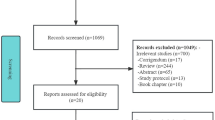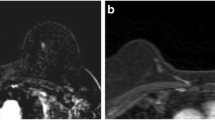Abstract
Purpose
Category 4 in BI-RADS for magnetic resonance imaging (MRI) has a wide range of probabilities of malignancy, extending from > 2 to < 95%. We classified category 4 lesions into three subcategories and analyzed the positive predictive value (PPV) of malignancy in a tertiary hospital.
Materials and methods
This retrospective study included 346 breast MRIs with 434 category 2–5 lesions. All enhancing lesions were classified as category 2 (0% probability of malignancy), 3 (> 0%, ≤ 2%), 4 (> 2%, < 95%) and 5 (≥ 95%); category 4 lesions were further subcategorized into 4A (> 2%, ≤ 10%), 4B (> 10%, ≤ 50%) and 4C (> 50%, < 95%) at the time of diagnosis. Radiological and pathological reports were retrospectively analyzed, and the PPVs were calculated.
Results
We included 149 malignant and 285 benign lesions. The PPVs of subcategories 4A, 4B and 4C were 1.8%, 11.8% and 67.5%, respectively. The PPVs were higher for lesions coexisting with category 5 or 6 lesions compared with those for isolated lesions.
Conclusion
Category 4 lesions can be classified into three subcategories depending on the likelihood of malignancy. Lesions coexisting with category 5 or 6 lesions are more likely to be malignant.




Similar content being viewed by others
References
D’Orsi CJ, Sickles EA, Mendelson EB, et al. ACR BIRADS® atlas, breast imaging reporting and data system. Reston: American College of Radiology; 2013.
Farghadani M, Soofi G, Sarrami A. Is there any correlation between magnetic resonance imaging features of breast lesions of BIRADS category 4 with histopathologic results? Adv Biomed Res Medknow. 2017;6:7.
Mahoney MC, Gatsonis C, Hanna L, DeMartini WB, Lehman C. Positive predictive value of BI-RADS MR imaging. Radiology. 2012;264:51–8.
Sakamoto N, Tozaki M, Higa K, Tsunoda Y, Ogawa T, Abe S, et al. Categorization of non-mass-like breast lesions detected by MRI. Breast Cancer. 2008;15:241–6.
Tozaki M, Igarashi T, Fukuda K. Breast MRI using the VIBE sequence: clustered ring enhancement in the differential diagnosis of lesions showing non-masslike enhancement. Am J Roentgenol. 2006;187:313–21.
Tozaki M, Fukuda K. High-spatial-resolution MRI of non-masslike breast lesions: Interpretation model based on BI-RADS MRI descriptors. Am J Roentgenol. 2006;187:330–7.
de Almeida JRM, Gomes AB, Barros TP, Fahel PE, Rocha MDS. Predictive performance of BI-RADS magnetic resonance imaging descriptors in the context of suspicious (category 4) findings. Radiol Bras. 2016;49:137–43.
Liberman L, Mason G, Morris EA, Dershaw DD, Sierra H, Cordova M, et al. Does size matter? Positive predictive value of MRI-detected breast lesions as a function of lesion size. Am J Roentgenol. 2006;186:426–30.
Iima M, Honda M, Sigmund EE, Ohno Kishimoto A, Kataoka M, Togashi K. Diffusion MRI of the breast: current status and future directions. J Magn Reson Imaging. 2019. https://doi.org/10.1002/jmri.26908.
Liu HL, Zong M, Wei H, Lou JJ, Wang SQ, Zou QG, et al. Differentiation between malignant and benign breast masses: combination of semi-quantitative analysis on DCE-MRI and histogram analysis of ADC maps. Clin Radiol. 2018;73:460–6.
De Almeida JRM, Gomes AB, Barros TP, Fahel PE, De Seixas RM. Subcategorization of suspicious breast lesions (BI-RADS Category 4) according to MRI criteria: Role of dynamic contrast-enhanced and diffusion-weighted imaging. Am J Roentgenol. 2015;205:222–31.
Fujiwara K, Yamada T, Kanemaki Y, Okamoto S, Kojima Y, Tsugawa K, et al. Grading system to categorize breast MRI in BI-RADS 5th edition: a multivariate study of breast mass descriptors in terms of probability of malignancy. Am J Roentgenol. 2018;210:W118–W12727.
Smith H, Chetlen AL, Schetter S, Mack J, Watts M, Zhu JJ. PPV 3 of suspicious breast MRI findings. Acad Radiol. 2014;21:1553–622.
Strigel RM, Burnside ES, Elezaby M, Fowler AM, Kelcz F, Salkowski LR, et al. Utility of BI-RADS assessment category 4 subdivisions for screening breast MRI. Am J Roentgenol. 2017;208:1392–9.
Asada T, Yamada T, Kanemaki Y, Fujiwara K, Okamoto S, Nakajima Y. Grading system to categorize breast MRI using BI-RADS 5th edition: a statistical study of non-mass enhancement descriptors in terms of probability of malignancy. Jpn J Radiol. 2018;36:200–8.
Liu D, Ba Z, Ni X, Wang L, Yu D, Ma X. Apparent diffusion coefficient to subdivide breast imaging reporting and data system magnetic resonance imaging (BI-RADS-MRI) category 4 lesions. Med Sci Monit. 2018;24:2180–8.
Marino MA, Clauser P, Woitek R, Wengert GJ, Kapetas P, Bernathova M, et al. A simple scoring system for breast MRI interpretation: does it compensate for reader experience? Eur Radiol. 2016;26:2529–37.
Yabuuchi H, Matsuo Y, Okafuji T, Kamitani T, Soeda H, Setoguchi T, et al. Enhanced mass on contrast-enhanced breast MR imaging: lesion characterization using combination of dynamic contrast-enhanced and diffusion-weighted MR images. J Magn Reson Imaging. 2008;28:1157–65.
Tozaki M, Igarashi T, Fukuda K. Positive and negative predictive values of BI-RADS®-MRI descriptors for focal breast masses. Magn Reson Med Sci. 2006;5:7–15.
Kinkel K, Helbich TH, Esserman LJ, Barclay J, Schwerin EH, Sickles EA, et al. Dynamic high-spatial-resolution MR imaging of suspicious breast lesions: diagnostic criteria and interobserver variability. Am J Roentgenol. 2000;175:35–433.
Mann RM, Balleyguier C, Baltzer PA, Bick U, Colin C, Cornford E, et al. Breast MRI: EUSOBI recommendations for women’s information. Eur Radiol. 2015;25:3669–788.
Acknowledgments
We would like to thank Sakurako Onaka for her help in organizing data. We thank Libby Cone, MD, MA, from Edanz Group Japan (www.edanzediting.com/ac) for editing a draft of this manuscript.
Author information
Authors and Affiliations
Contributions
All authors above contributed to the study conception and design. Data collection and analysis were performed by MH and MK. The first draft of the manuscript was written by MH and all the other authors commented on previous versions of the manuscript. All authors read and approved the final manuscript.
Corresponding author
Ethics declarations
Conflict of interest
M. Toi received honorarium from Eli Lilly and research funding from Chugai, Astellas, AstraZeneca, AFI technology, Shimadzu and Kyowa-Kirin. The remaining authors declare no conflicts of interest.
Informed consent
The need for informed consent was waived because we retrospectively analyzed the reports of clinically acquired breast MRI scans.
Additional information
Publisher's Note
Springer Nature remains neutral with regard to jurisdictional claims in published maps and institutional affiliations.
About this article
Cite this article
Honda, M., Kataoka, M., Kawaguchi, K. et al. Subcategory classifications of Breast Imaging and Data System (BI-RADS) category 4 lesions on MRI. Jpn J Radiol 39, 56–65 (2021). https://doi.org/10.1007/s11604-020-01029-w
Received:
Accepted:
Published:
Issue Date:
DOI: https://doi.org/10.1007/s11604-020-01029-w




